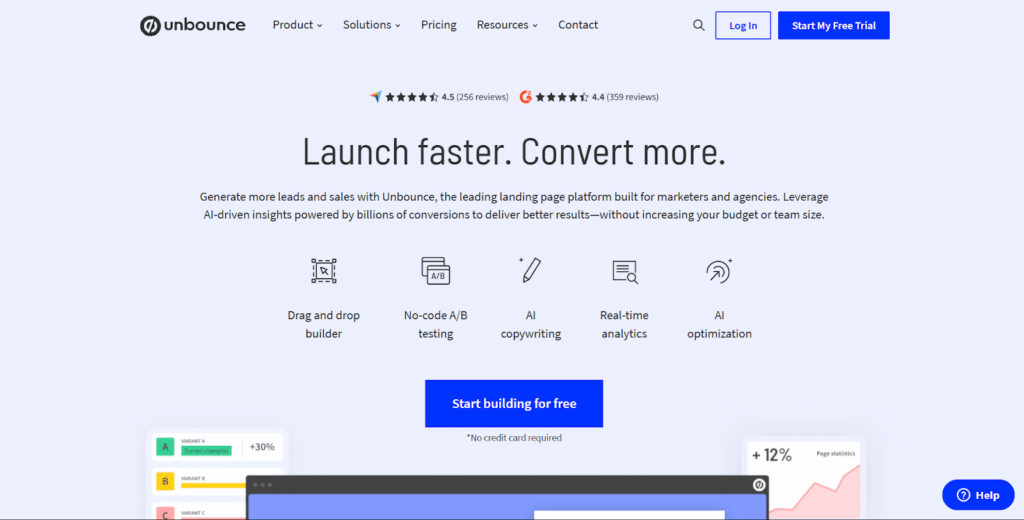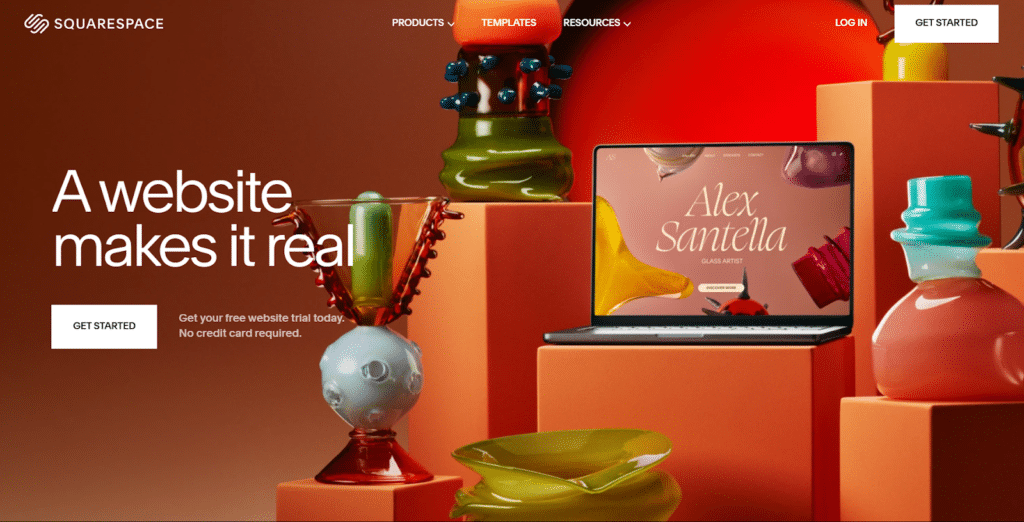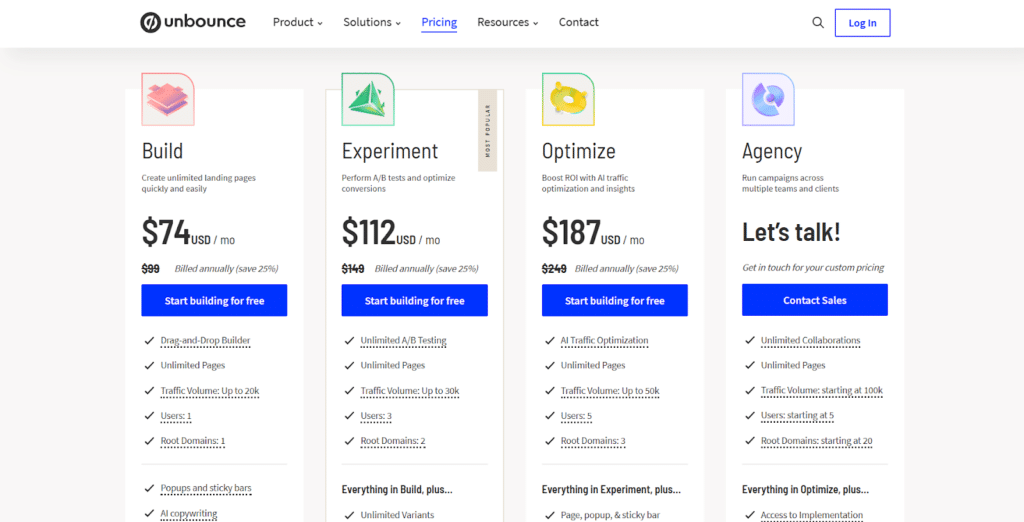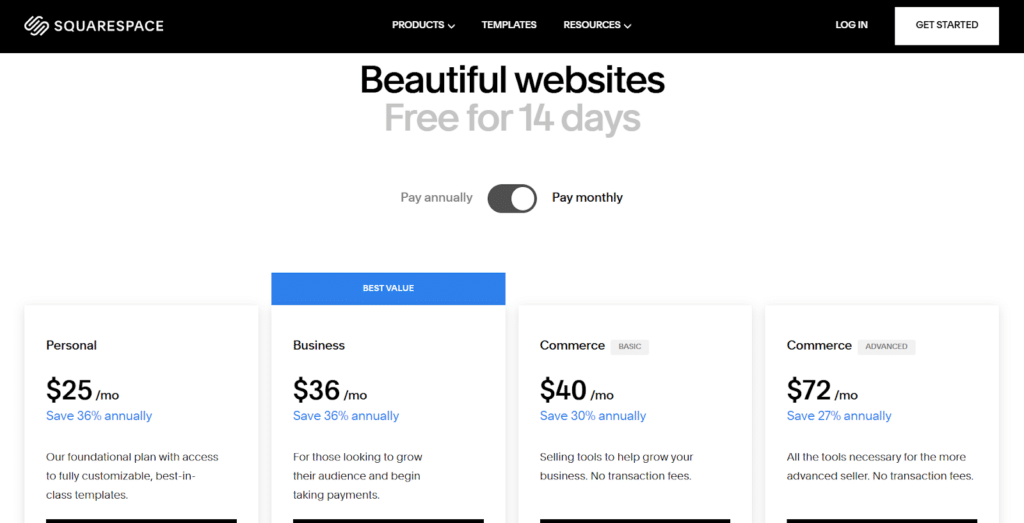Aap Unbounce vs Squarespace: A Comprehensive Platform Comparison
When creating an online presence, businesses face important decisions about which platform best suits their specific needs. Unbounce and Squarespace represent two fundamentally different approaches to web presence: Unbounce as a specialized landing page builder focused on conversion optimization, and Squarespace as a comprehensive website builder emphasizing design and user experience. This detailed comparison will help you understand the strengths, limitations, and ideal use cases for each platform, enabling you to make an informed choice based on your business goals and requirements.
Overview of Unbounce

Unbounce is a dedicated landing page platform designed specifically for marketers who want to create, test, and optimize high-converting landing pages without requiring developer assistance. Founded in 2009 as one of the pioneering landing page builders, Unbounce has evolved to incorporate AI-powered features that help businesses maximize conversion rates for their marketing campaigns.
Key Features of Unbounce
- Smart Builder: AI-powered drag-and-drop builder with responsive design capabilities and conversion-focused elements.
- Classic Builder: Traditional drag-and-drop editor offering pixel-perfect control over page elements.
- Conversion Intelligence: Tools like Smart Traffic that automatically direct visitors to the page variant most likely to convert based on their attributes.
- Smart Copy: AI writing assistant to help create compelling headlines, CTAs, and page content.
- A/B Testing: Built-in split testing capabilities to optimize page performance.
- Dynamic Text Replacement (DTR): Automatically customize page content to match search keywords from ads.
- Pop-ups and Sticky Bars: Create targeted overlays and notification bars to boost conversions across your website.
- Template Library: 100+ professionally designed templates optimized for conversions.
- Integrations: Connects with major CRMs, email platforms, and marketing tools.
Ideal User Base for Unbounce
- Digital marketers focused on campaign-specific landing pages
- PPC specialists running search and social advertising campaigns
- Marketing teams needing quick deployment of conversion-focused pages
- Businesses prioritizing lead generation and conversion optimization
- Agencies managing multiple client landing pages
- Companies wanting to test and optimize marketing campaigns
Overview of Squarespace

Squarespace is an all-in-one website building and hosting platform known for its visually striking templates and intuitive design interface. Founded in 2003, Squarespace has established itself as a leading solution for creating professional websites with a focus on aesthetics, user experience, and content presentation. The platform combines website building, hosting, domain registration, and e-commerce capabilities in a single integrated service.
Key Features of Squarespace
- Visual Website Builder: Intuitive drag-and-drop interface for creating professional websites without coding.
- Designer Templates: Dozens of professionally designed, mobile-responsive templates organized by industry and purpose.
- Blogging Platform: Built-in blogging tools with categories, tags, and commenting systems.
- E-commerce Capabilities: Online store functionality with product management, checkout, and payment processing.
- Content Management: Tools for organizing and presenting various content types including galleries, portfolios, and blogs.
- SEO Tools: Built-in features for improving search visibility including customizable metadata and structured data.
- Analytics: Native analytics dashboard showing traffic sources, popular content, and visitor behavior.
- Marketing Tools: Email campaigns, social media integration, and promotional pop-ups.
- Domain Registration: Included domain name with annual plans or integration with existing domains.
Ideal User Base for Squarespace
- Creative professionals showcasing portfolios (photographers, artists, designers)
- Small businesses needing a professional web presence
- Restaurants, cafes, and local service businesses
- E-commerce businesses with visually-focused products
- Bloggers and content creators prioritizing aesthetics
- Professionals needing both website and simple online store functionality
- Users valuing design quality and ease of use over technical customization
Core Functionalities Comparison
Understanding how Unbounce and Squarespace compare across key functionality areas will help you determine which platform better meets your specific requirements.
1. Purpose and Core Focus
Unbounce is purposely built for creating standalone landing pages optimized specifically for conversion. Its features are centered around turning visitors into leads or customers through targeted messaging, A/B testing, and conversion optimization. Unbounce isn't designed for building comprehensive websites with multiple interconnected pages, blogs, or complex navigation structures. Its strength lies in creating high-performing campaign pages rather than complete web presences.
Squarespace is designed as a complete website solution that prioritizes design quality, user experience, and content presentation. Its core focus is helping users create cohesive, professional websites that effectively represent their brand across multiple pages and content types. While conversion elements like forms and call-to-action buttons are available, they're integrated into the broader website experience rather than being the platform's primary focus.
2. Page Building Experience
Unbounce offers two distinct builders: the traditional Classic Builder and the newer Smart Builder. The Classic Builder provides pixel-perfect control with free-form drag-and-drop functionality, allowing precise placement of elements anywhere on the page. The Smart Builder uses AI to guide design decisions with conversion best practices built in. Both builders are specifically tailored for creating landing pages with clear conversion goals rather than general-purpose web pages.
Squarespace utilizes a section-based page building approach that maintains design consistency while providing flexibility. The editor allows users to add, remove, and rearrange content blocks within a structured framework that ensures professional results even without design expertise. This approach prioritizes aesthetic coherence and responsive design across devices, making it difficult to create “bad-looking” pages but somewhat less flexible for specific marketing layouts compared to Unbounce.
3. Templates and Design
Unbounce provides over 100 landing page templates specifically designed for conversion goals across various industries. Templates are categorized by objective (lead generation, click-through, sales, etc.) and industry, focusing on layouts and elements proven to drive conversions. While visually professional, Unbounce templates prioritize conversion principles over pure aesthetics, with clear value propositions, prominent call-to-action buttons, and streamlined content presentation.
Squarespace is renowned for its visually stunning templates, offering dozens of professionally designed starting points organized by industry and purpose. Templates feature sophisticated typography, thoughtful whitespace, and professional imagery that create a premium feel. Squarespace templates are designed as complete website frameworks with consistent styling across multiple page types (home, about, contact, blog, products, etc.), rather than standalone pages. The design emphasis is on brand presentation and user experience rather than explicit conversion optimization.
4. Conversion Optimization Features
Unbounce excels in conversion optimization with specialized features built specifically for this purpose. Smart Traffic automatically directs visitors to the landing page variant where they're most likely to convert based on their attributes. A/B testing capabilities allow for systematic optimization, while Dynamic Text Replacement increases ad relevance by automatically matching landing page content to search keywords. Unbounce also provides integrated heatmaps, analytics focused on conversion metrics, and conversion-centered design elements.
Squarespace offers basic conversion elements like contact forms, newsletter sign-ups, and call-to-action buttons, but lacks advanced conversion optimization features. There's no native A/B testing capability, and analytics focus on general website metrics rather than conversion-specific data. While Squarespace allows for creating effective marketing pages, it doesn't provide the specialized tools for systematically testing and optimizing conversions that Unbounce offers as its core functionality.
5. E-commerce Capabilities
Unbounce has limited e-commerce functionality, primarily focused on integrating with external payment processors for simple transactions. While you can create product-focused landing pages and implement payment buttons from services like Stripe or PayPal, Unbounce isn't designed for managing product catalogs, processing orders, or handling inventory. Its e-commerce capabilities are best suited for selling single products or services directly from landing pages rather than creating a complete online store.
Squarespace includes robust e-commerce functionality with its Business and Commerce plans. The platform offers product management, inventory tracking, tax calculation, shipping options, discount codes, and integrated checkout experiences. Squarespace Commerce supports physical products, digital downloads, services, and subscriptions. The e-commerce features are fully integrated with the website builder, allowing for consistent branding and seamless user experience between content pages and shop sections.
6. Content Management and Blogging
Unbounce does not include content management or blogging functionality. While landing pages can contain text and media elements, there's no system for organizing, categorizing, or regularly publishing content. Unbounce pages are designed as standalone marketing assets rather than components of a content strategy, making the platform unsuitable for businesses focused on content marketing without additional tools.
Squarespace offers comprehensive content management capabilities, including a full-featured blogging platform with categories, tags, author profiles, and commenting systems. The platform excels at presenting various content types through galleries, portfolios, event calendars, and media collections. Squarespace's content tools support scheduling, drafts, and revision history, making it well-suited for businesses where regular content publication is central to their strategy.
Pricing Comparison: Unbounce vs Squarespace
Understanding the pricing structures of both platforms is crucial for making a cost-effective decision based on your business requirements.
Unbounce Pricing Plans

Unbounce offers several pricing tiers based primarily on conversion volume and feature access:
Build Plan ($74/month when billed monthly)
- 500 conversions
- 20,000 visitors
- 1 domain
- Smart Builder
- Smart Copy
- Pop-ups and Sticky Bars
- Email support
Experiment Plan ($112/month when billed monthly, $131/month when billed annually)
- 1,000 conversions
- 30,000 visitors
- 5 domains
- Everything in Launch
- A/B testing
- Smart Traffic
- Quick loading AMP pages
- Email and chat support
Optimize Plan ($187/month when billed monthly)
- 2,500 conversions
- 50,000 visitors
- 10 domains
- Everything in Optimize
- Client sub-accounts
- Custom reporting
- Page redirects
- Priority support
Agency Plan (Custom pricing)
- Custom conversion, visitor, and domain limits
- Everything in Accelerate
- Custom templates and integrations
- Dedicated success team
- Advanced training and support
Unbounce's pricing is primarily based on conversion volume and visitor limits, with higher tiers offering more advanced features and support options
Squarespace Pricing Plans
Squarespace offers multiple pricing plans, catering to individuals, businesses, and eCommerce stores.

The Personal Plan costs $25 per month when billed monthly or at a discounted annual rate. It includes fully customizable, mobile-optimized website templates, a free custom domain, and essential website-building features, making it ideal for personal projects or simple websites.
The Business Plan, priced at $36 per month, is designed for users looking to expand their online presence. It includes everything from the Personal Plan, plus advanced website analytics, checkout on your domain, advanced shipping options, and a 3% transaction fee on online store transactions.
For eCommerce, Squarespace offers Commerce Basic at $40 per month, eliminating transaction fees on store sales while providing advanced merchandising tools, checkout on your domain, and powerful shipping features.
The Commerce Advanced Plan costs $72 per month and is ideal for high-volume sellers. It includes all the features from the Basic plan, plus advanced discounting, subscription selling options, and additional tools for scaling a business.
For larger businesses, Squarespace provides Enterprise Solutions, offering custom pricing tailored to specific needs.
All plans come with a 14-day free trial, and annual billing options provide significant savings. Squarespace does not charge transaction fees on invoices, making it a cost-effective option for businesses and creators.
Making the Right Choice for Your Business
Choosing between Unbounce and Squarespace depends on your specific marketing goals, business needs, and priorities. Here's guidance to help you make the most appropriate decision:
Choose Unbounce if:
- Your primary goal is creating high-converting landing pages for marketing campaigns
- You're running PPC or social media ad campaigns requiring dedicated landing pages
- Conversion optimization is your top priority
- You need advanced features like A/B testing and dynamic content
- You already have a main website and need specialized campaign pages
- You want AI-powered conversion optimization tools
- Your marketing strategy focuses on lead generation through targeted campaigns
- You need detailed conversion analytics and testing capabilities
Choose Squarespace if:
- You need a complete website rather than standalone landing pages
- Visual design and aesthetics are paramount for your brand
- You're creating a portfolio, blog, or content-focused website
- You need integrated e-commerce functionality
- You want an all-in-one solution for website building and hosting
- You prioritize ease of use and professional design without technical complexity
- Content management and regular publishing are important to your strategy
- You need a cohesive, multi-page website with consistent branding
Many businesses actually benefit from using both platforms for different purposes. Squarespace can serve as the main website platform, providing comprehensive brand presence and content management, while Unbounce handles campaign-specific landing pages that require optimization and testing. This approach leverages the strengths of each platform: Squarespace for overall web presence and Unbounce for conversion-focused marketing campaigns.
Ultimately, your choice should align with your business objectives, marketing strategy, and resource availability. Consider your primary goals, whether they lean toward comprehensive brand presentation or focused conversion optimization, when deciding which platform better serves your current needs.